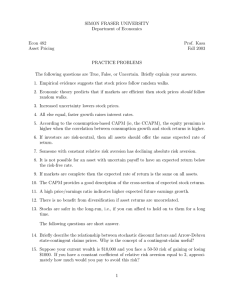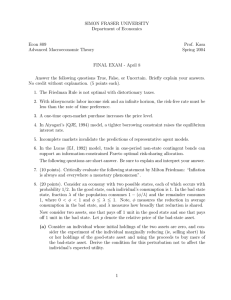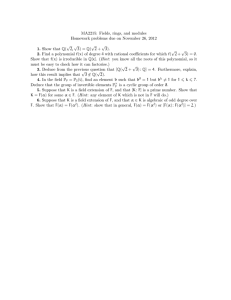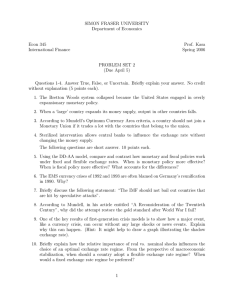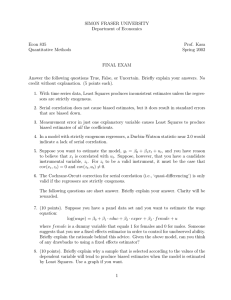SIMON FRASER UNIVERSITY Department of Economics Econ 808 Prof. Kasa
advertisement
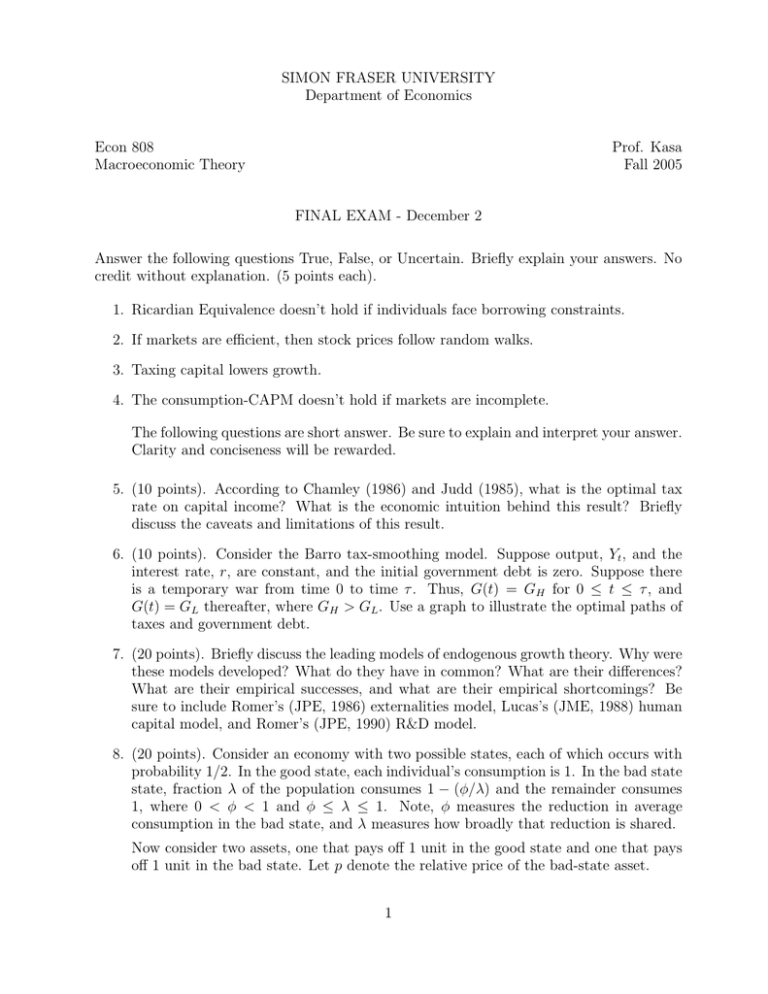
SIMON FRASER UNIVERSITY Department of Economics Econ 808 Macroeconomic Theory Prof. Kasa Fall 2005 FINAL EXAM - December 2 Answer the following questions True, False, or Uncertain. Briefly explain your answers. No credit without explanation. (5 points each). 1. Ricardian Equivalence doesn’t hold if individuals face borrowing constraints. 2. If markets are efficient, then stock prices follow random walks. 3. Taxing capital lowers growth. 4. The consumption-CAPM doesn’t hold if markets are incomplete. The following questions are short answer. Be sure to explain and interpret your answer. Clarity and conciseness will be rewarded. 5. (10 points). According to Chamley (1986) and Judd (1985), what is the optimal tax rate on capital income? What is the economic intuition behind this result? Briefly discuss the caveats and limitations of this result. 6. (10 points). Consider the Barro tax-smoothing model. Suppose output, Yt , and the interest rate, r, are constant, and the initial government debt is zero. Suppose there is a temporary war from time 0 to time τ . Thus, G(t) = GH for 0 ≤ t ≤ τ , and G(t) = GL thereafter, where GH > GL . Use a graph to illustrate the optimal paths of taxes and government debt. 7. (20 points). Briefly discuss the leading models of endogenous growth theory. Why were these models developed? What do they have in common? What are their differences? What are their empirical successes, and what are their empirical shortcomings? Be sure to include Romer’s (JPE, 1986) externalities model, Lucas’s (JME, 1988) human capital model, and Romer’s (JPE, 1990) R&D model. 8. (20 points). Consider an economy with two possible states, each of which occurs with probability 1/2. In the good state, each individual’s consumption is 1. In the bad state state, fraction λ of the population consumes 1 − (φ/λ) and the remainder consumes 1, where 0 < φ < 1 and φ ≤ λ ≤ 1. Note, φ measures the reduction in average consumption in the bad state, and λ measures how broadly that reduction is shared. Now consider two assets, one that pays off 1 unit in the good state and one that pays off 1 unit in the bad state. Let p denote the relative price of the bad-state asset. 1 (a) Consider an individual whose initial holdings of the two assets are zero, and consider the experiment of the individual marginally reducing (ie, selling short) his or her holdings of the good-state asset and using the proceeds to buy more of the bad-state asset. Derive the condition for this perturbation not to affect the individual’s expected utility. (b) Since consumption in the two states is exogenous and individuals are ex ante (but not ex post) identical, p must adjust to the point where it is an equilibrium for everyone’s holdings of both assets to be zero. Solve the condition derived in part (a) for this equilibrium value of p. [Hint: The answer should be in terms of φ, λ, U (1), and U (1 − (φ/λ))]. (c) Calculate ∂p/∂λ, and show that if utility is quadratic then, ∂p/∂λ = 0. (d) Show that if U (·) is everywhere positive then ∂p/λ < 0. Interpret this result intuitively, and relate it to the analysis in Constantinides and Duffie (JPE, 1996). 9. (20 points). Consider an economy in which output, Y (t), capital, K(t), and consumption, C(t), are related as follows: Y (t) = F (K(t), L) = [K(t)γ + Lγ ]1/γ K̇(t) = Y (t) − C(t) − δK(t) where L > 0 is the fixed supply of labor, δ > 0 is the depreciation rate of capital, and γ ≤ 1 is a fixed production function parameter. (a) Show that the production function has constant returns to scale. Show that the elasticity of substitution between capital and labor is equal to 1/(1−γ). For what value of γ is the production function Cobb-Douglas? (b) Show that the production function can be written as, y = f (k), where y = Y /L and k = K/L. (c) Derive an expression for the net rate of return to capital, r = f (k) − δ, and show that in the limit, as k → ∞, this rate tends to −δ if γ ≤ 0, whereas it tends to 1 − δ if γ > 0. (d) Suppose preferences are given by U= ∞ 0 log[c(t)]e−ρt dt For what values of γ and ρ will there be endogenous growth? (Hint: Use the consumption Euler equation and your answer to part (c)). Why might this not be such a great model of endogenous growth? (Hint: Would it be consistent with observed factor share data?). 2
